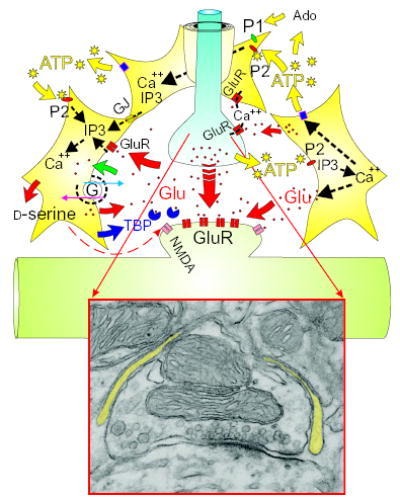Fig. 3.

Synaptic astrocytes (yellow) regulate synaptic transmission by responding to signaling molecules, such as ATP and glutamate, released from the presynaptic neuron during synaptic transmission. Astrocytes communicate with adjacent astrocytes via gap junctions (GJ) and with distant astrocytes via extracellular ATP. The rise in Ca2+ causes release of glutamate from astrocytes, and ATP is released via an unknown mechanism, which propagates ATP signaling to adjacent cells. Astrocytes may also regulate synaptic transmission by uptake of glutamate from the synaptic cleft via membrane transporters (green arrow) or the release of glutamate upon reversal of the transporter induced by elevated intracellular Na+ (red arrow). Other substances, such as d-serine, strengthen synaptic transmission by coactivating NMDA receptors in the postsynaptic membrane, or reduce synaptic transmission by secreting transmitter-binding proteins ( TBP). (Inset) An electron micrograph of a synapse surrounded by an astrocyte (yellow) from the spinal cord of rat (Courtesy of M. H. Ellisman, National Center for Microscopy and Imaging Research, University of California, San Diego). GluR, glutamate receptor; Ado, adenosine; IP3, inositol trisphosphate; P1, adenosine receptor; P2, ATP receptor.
